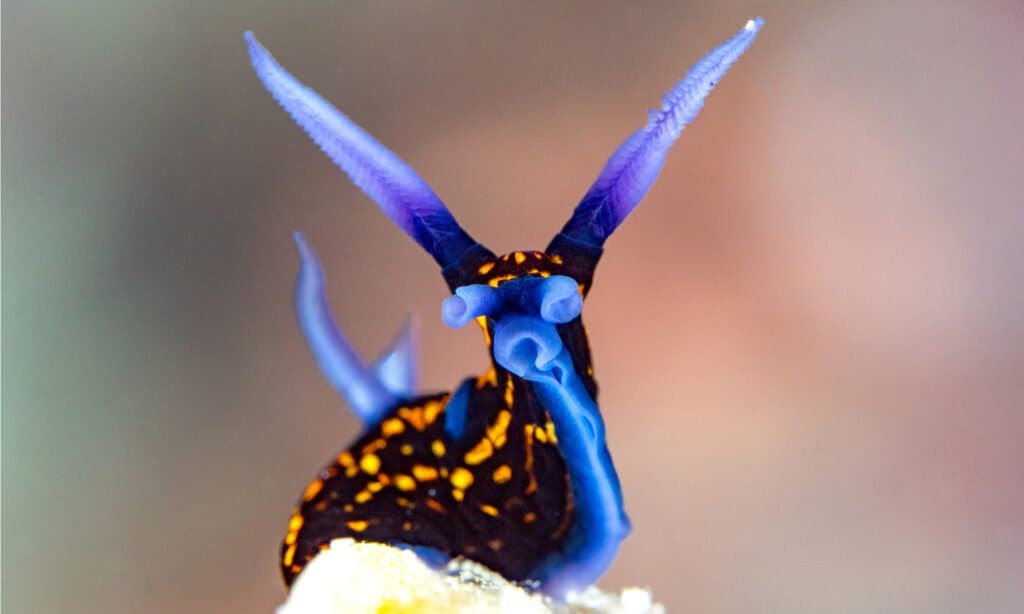Nudibranch
Nudibranchia
They get toxins from their prey to use it against predators.
Advertisement
Nudibranch Scientific Classification
- Kingdom
- Animalia
- Phylum
- Mollusca
- Class
- Gastropoda
- Order
- Nudibranchia
- Scientific Name
- Nudibranchia
Read our Complete Guide to Classification of Animals.
Nudibranch Conservation Status
Nudibranch Facts
- Prey
- Other nudibranches or sea slugs, coral, anemones, sponges, hydrozoans, planktonic invertebrates, sea butterflies, or other sea creatures depending on the species
- Group Behavior
- Solitary
- Fun Fact
- They get toxins from their prey to use it against predators.
- Estimated Population Size
- unknown
- Biggest Threat
- None
- Most Distinctive Feature
- Bright colors and various forms
- Other Name(s)
- Sea slug
- Gestation Period
- 5-50 days depending on the species
- Habitat
- Saltwater, brackish water
- Predators
- Other nudibranchs, turtles, some crabs, humans
- Diet
- Carnivore
- Type
- Mollusk
- Common Name
- Sea slug
View all of the Nudibranch images!
The nudibranch is a soft-bodied marine gastropod mollusk, also called a sea slug, that sheds its shell after the larval stage. Its name means “naked gill.” Some species steal the nematocysts, or stinging cell organelles, of predators in order to release the toxins as a defensive mucus against them. The creature lives in all depths in mostly saltwater around the world, while a few species live in brackish water.
5 Nudibranch Facts
- Nudibranchs are carnivorous.
- They are hermaphrodites.
- Some absorb chloroplasts from algae to benefit from photosynthesis, which gives them energy.
- There is a pair of tentacles (rhinophores) with scent receptors on their heads, which they can hide from predators in a flesh pocket.
- Nudibranch means “naked gill.”
Classification and Scientific Name
The scientific name of the nudibranch is Nudibranchia. One of the interesting scientific facts about this creature is that it is one type of sea slug or opisthobranchs in the phylum Mollusca (mollusks), in the order Nudibranchia. The phylum Mollusca includes snails, slugs, limpets, and sea hairs. Nudibranch means “naked gill” and comes from the Latin word nudus (naked) and Greek brankhia (gills). The creatures are divided into two types: dorid and aeolid, which are suborders Doridacea and Aeolidida. There are other types of sea slugs that are not closely related to nudibranchs.
Nudibranch Species
3,000 species of nudibranchs exist. Some examples are:
- Anemone sea slug (Berghia coerulescens), lives in the waters of the Mediterranean and Atlantic Ocean
- Blue dragon, blue angel, or sea swallow (Glaucus Atlanticus) lives in temperate and tropical waters around the world
- Berghia nudibranch (Berghia stephanieae) lives in the warm and temperate waters of the Atlantic Ocean, Caribbean, and Mediterranean
- Opalescent sea slug (Hermissenda opalescens), lives in both sides of the Pacific Ocean
- Hooded nudibranch, lion nudibranch or lion’s mane nudibranch (Melibe leonina), lives in the eastern Pacific Ocean of North America ranging from Alaska to Baja, California
- Sea bunny (Jorunna parva), a dorid, lives in the waters of Japan, the Phillippines, Oceania, and the Indian Ocean
- Phyllodesmium poindimiei, an aeolid, lives in tropical waters around the world
Appearance
The facts about the appearance of nudibranchs show that they have different sizes, forms and stunning, vivid colors depending on the species. They are often confused for other types of sea slugs, such as Sacoglossa and Aglajidae, which are not closely related to them. The size of the nudibranch ranges from 20 to 600mm or 0.25 to 1.5ft, with a weight of up to 3.3lbs. Dorids are smooth with feather-like gill plumes in the back, while aeolids have cerata over their backs to breathe with.
- Anemone sea slug (Berghia coerulescens), an aeolid, has s size of 40-70mm
- Blue dragon, blue angel, or sea swallow (Glaucus Atlanticus), an aeolid, is 1.2in long, has dark blue head stripes, a tapering, flat body and six appendages displaying cerata, dark pale blue sides and a silvery grey belly
- Berghia nudibranch (Berghia stephanieae), an aeolid, is up to 20mm long
- Opalescent sea slug (Hermissenda opalescens), an aeolid, has bright colors
- Hooded nudibranch, lion nudibranch or lion’s mane nudibranch (Melibe leonina), an aeolid, has a pale, translucent yellor green body, 102mm length and 25mm width, a large oral hood usually over 51mm wide with 2 rows of cirri, a single pair of rhinophores, and two rows of three to six pairs of cerata
- Sea bunny (Jorunna parva), a dorid, has an average size of 1cm long, black-and-white rhinophores similar to rabbit ears, a body that is yellow, white, or green and covered in papillae that are black as well as those of their main color
- Phyllodesmium poindimiei, an aeolid

Nudibranch is also known as the sea slug, and here you can see why.
©Mike Workman/Shutterstock.com
Distribution, Population, and Habitat
Nudibranchs are in all the world’s oceans, both cold and warm water. They can be found on the seafloor and at all depth levels from 30-6,500ft below the surface.
Nudibranch Predators and Prey
Nudibranchs are carnivores, meaning they eat other animals. Many species have a main prey. The Favorinus genus eats other sea slugs and their eggs, and Robastra eats other nudibranchs. Onchidoris bilamellata eats barnacles, Cladobranchia (including Aeolididae) eats anemones, and others eat sea sponges or other creatures.
- Anemone sea slug (Berghia coerulescens), eats aiptasia, a coral or anemone species
- Blue dragon, blue angel, or sea swallow (Glaucus Atlanticus) eats hydrozoeans, such as the Portuguese Man O’ War
- Berghia nudibranch (Berghia stephanieae), eats aiptasia
- Opalescent sea slug (Hermissenda opalescens) eats sea anemones, bryzoans (moss animals), sea pens, sea squirts, corals, sponges, small crustaceans, and others of its kind
- Hooded nudibranch, lion nudibranch or lion’s mane nudibranch (Melibe leonina), eats planktonic invertebrates
- Sea bunny (Jorunna parva), a dorid, eats sea butterflies
- Phyllodesmium poindimiei, an aeolid, eats Alcyonacea, including Carijoa riisei, a soft coral species
Nudibranch Reproduction and Lifespan
All nudibranch species are hermaphroditic, meaning they have both male and female sexual organs. However, they cannot fertilize themselves, so they have to meet another nudibranch to reproduce with them. They start with a courtship ritual of dancing. During the few minutes of mating, one deposits their eggs in a gelatinous spiral, while the other donates sperm. They can lay 1-2 or as many as 25 million eggs, which all contain toxins from sea sponges for defense against predators. The baby nudibranchs look like adults except for their smaller size and fewer cerata. Nudibranchs’ lifespan ranges from a few weeks to a year or up to 4 years depending on the species.
Nudibranch in Fishing and Cooking
Sea slugs are caught and sold as exotic pets. They are also eaten in some parts of Asia, including China, where their skin is roasted and eaten with vegetables, such as cabbage and mushrooms.
Nudibranch Population
No nudibranch species are listed as vulnerable, threatened, or endangered. The hydrothermal vent nudibranch (Dendronotus comteti) has an unknown population and is listed as Least Concern.
View all 65 animals that start with NNudibranch FAQs (Frequently Asked Questions)
Are nudibranchs poisonous to humans?
Most are harmless, except for Glaucus atlanticus, which eats nematocytes and can use them against humans.
Can you have a nudibranch as a pet?
Depending on exotic pet laws in your area, nudibranchs may or may not be illegal to have as pets.
Why are nudibranchs poisonous?
They are poisonous to all non-humans because of the venomous or poisonous prey they eat. They store their stinging cells and release them against predators.
What is the difference between a sea slug and a nudibranch?
All nudibranchs are sea slugs, but not all sea slugs are nudibranchs.
What do nudibranchs eat?
Their diet is carnivorous and they eat other sea creatures, depending on the species.
Where do nudibranchs live?
They live in salt and brackish waters around the world.
How do you pronounce nudibranch?
Nudibranch is pronounced “nooda-bronk”
What are the key differences between sea slugs and nudibranchs?
The key differences between sea slugs and nudibranchs are size, behavior, where they are found, diet, reproduction, defense mechanism, and predators.
Thank you for reading! Have some feedback for us? Contact the AZ Animals editorial team.


















